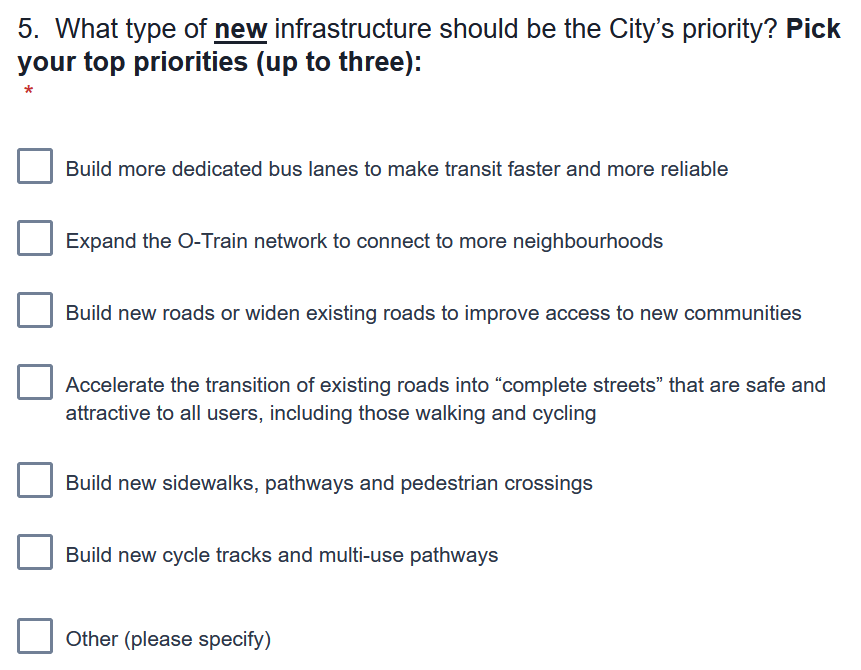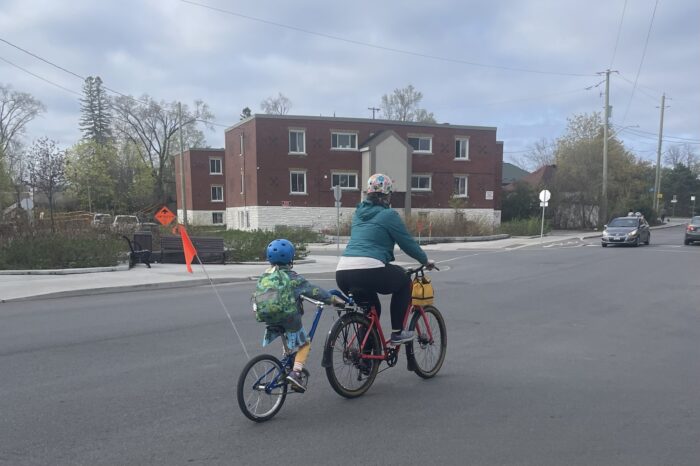The City of Ottawa not only refuses to acknowledge a basic principle of transportation planning, but is propagating a myth.
The city recently launched Phase 4 of its Transportation Master Plan Update. This phase will see consultation on the TMP’s Part 2, which identifies new road transportation projects and determines their rollout.
Part of this consultation is a survey that asks the public’s opinion about Transportation Investment Priorities. The survey poses a series of questions about how respondents would like limited resources invested—in maintaining existing infrastructure or building new, in sustainable transportation or vehicular travel, and so on.
One question in particular caught the eye of several advocates. It began by asking, “What type of new infrastructure should be the City’s priority? Pick your top priorities (up to three).” Among the options was this:

This option will raise red flags for anyone who’s scratched the surface of transportation research.
On the face of things, the notion that widening roads reduces car congestion seems logical: if car traffic is moving slowly, it’s because there’s not enough room—right? Actually, no. In reality, precisely the opposite is true: widening roads increases traffic. This is the well-documented phenomenon of induced demand, which states that when you provide something valuable for free, demand will increase—to the point of outstripping supply. With transportation, adding car facilities means you’ll get more cars. (Incidentally, this also works for other modes: adding sidewalks increases pedestrian traffic, and adding bike facilities increases people biking.)
A member of the public could be forgiven for not knowing this principle: it’s initially counterintuitive. But when it comes to government officials—and particularly transportation planners—there’s no excuse. As the urbanism publication Strong Towns describes it, “political leaders and transportation agencies refuse to believe that this same basic principle will apply when they spend billions to widen or expand highways in the name of ‘solving’ traffic congestion in urban regions, and then give away all of that newly created space for free.” When transportation planners don’t account for induced demand, it’s willful ignorance.
It’s one thing for the City to plan its transportation network in denial of induced demand; but it’s another to mislead the public on it. (We’ve similarly heard City staffers share the widely held misconception that shifting from car infrastructure to active transportation infrastructure is bad for businesses. The opposite is true.)
This decision is all the more problematic in that Council passed a motion last April that explicitly required staff to “include due consideration of induced demand and GHG emissions in the development and evaluation of the transit and road networks in the next phase of the Transportation Master Plan” (see Motion No.2023 – 13/04 in the minutes of this Council meeting). This was a good motion. Staff, who serve “at the pleasure of Council,” in the common formulation, are wholesale ignoring Council’s explicit instructions to them.
To be sure, the City has responded to advocates: they removed the option in question.

That said, the replacement—”Build new roads or widen existing roads to improve access to new communities”—is similarly problematic. It doubles down on road widening as a transportation solution while also embedding the assumption that “access” is by car. That’s right: the only people “accessing” new communities are those driving. If you walk, bike, or take transit, you don’t exist to the City.
Would you be ok with your physician offering you quack medicine as a treatment option? Probably not.
It’s high time that the City start taking seriously not only the climate emergency— which Council declared in 2019—but basic principles of transportation dynamics. Willful ignorance is no longer acceptable. Misleading the public is even worse.
If you’re bothered by this, please consider contacting the TMP team, the chair of the Transportation Committee, Tim Tierney, and/or your councillor. And don’t forget to submit feedback on the TMP Part 2!

